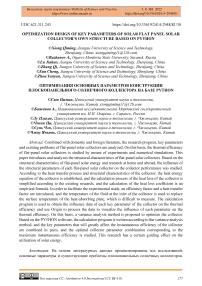Optimization design of key parameters of solar flat panel solar collector’s own structure based on Python
Автор: Xiong Qiming, Bazhanov Andrei, Lu Jiahao, Zhang Qi, Sun Cheng, Zhou Yanyan
Журнал: Бюллетень науки и практики @bulletennauki
Рубрика: Технические науки
Статья в выпуске: 8 т.8, 2022 года.
Бесплатный доступ
Combined with domestic and foreign literature, the research progress, key parameters and existing problems of flat-panel solar collectors are analyzed. On this basis, the thermal efficiency of flat-panel solar collectors is studied by means of experiments and numerical simulations. This paper introduces and analyzes the structural characteristics of flat-panel solar collectors. Based on the structural characteristics of flat-panel solar energy and research at home and abroad, the influence of the structural parameters of each flat-panel solar collector on the collector performance was studied. According to the heat transfer process and structural characteristics of the collector, the heat energy equation of the collector is established, and the calculation process of the heat loss of the collector is simplified according to the existing research, and the calculation of the heat loss coefficient is an empirical formula. In order to facilitate the experimental study, an efficiency factor and a heat transfer factor are introduced, and the temperature of the fluid at the inlet of the collector is used to replace the surface temperature of the heat-absorbing plate, which is difficult to measure. The calculation program is used to obtain the influence data of each key parameter of the collector on the thermal efficiency and use Origin to process the data to visualize the influence of each parameter on the thermal efficiency. On this basis, a variance analysis method is proposed to optimize the collector. Based on the PYTHON software, the calculation program is written according to the variance analysis method, and the key parameters that will greatly affect the instantaneous efficiency of the collector are combined in pairs, and the optimal collector parameter combination corresponding to the maximum instantaneous efficiency is studied. This research has a certain guiding effect on the utilization of solar energy.
Solar energy, collector, two-way anova, python
Короткий адрес: https://sciup.org/14125299
IDR: 14125299 | УДК: 621.311.243 | DOI: 10.33619/2414-2948/81/30
Список литературы Optimization design of key parameters of solar flat panel solar collector’s own structure based on Python
- Pandey, K. M., & Chaurasiya, R. (2017). A review on analysis and development of solar flat plate collector. Renewable and Sustainable Energy Reviews, 67, 641-650. https://doi.org/10.1016Zj.rser.2016.09.078
- Xu, Y., Xuan, Y., & Liu, X. (2017). Broadband photon management of subwavelength structures surface for full-spectrum utilization of solar energy. Energy Conversion and Management, 152, 22-30. https://doi.org/10.1016Zj.enconman.2017.09.036
- Chang, W., Wang, Y., Li, M., Luo, X., Ruan, Y., Hong, Y., & Zhang, S. (2015). The theoretical and experimental research on thermal performance of solar air collector with finned absorber. Energy Procedia, 70, 13-22. https://doi.org/10.10167j.egypro.2015.02.092
- Wang, J., Yu, Y., & Tang, J. (2018). Compensation and profit distribution for cooperative green pickup and delivery problem. Transportation Research Part B: Methodological, 113, 54-69. https://doi.org/10.1016/j.trb.2018.05.003
- Kili9, F., Menlik, T., & Sozen, A. (2018). Effect of titanium dioxide/water nanofluid use on thermal performance of the flat plate solar collector. Solar Energy, 164, 101-108. https://doi.org/10.1016/j.solener.2018.02.002
- Ziyadanogullari, N. B., Yucel, H. L., & Yildiz, C. (2018). Thermal performance enhancement of flat-plate solar collectors by means of three different nanofluids. Thermal Science and Engineering Progress, 8, 55-65. https://doi.org/10.1016/j.tsep.2018.07.005
- Bie, Y., Li, M., & Chen, F. (2017). Heat loss properties of cavity absorber in solar collecting system with parabolic trough concentrator. Acta energiae solaris sinica, 38(2), 423-430.
- Xu, L., Sun, F., Ma, L., Li, X., Yuan, G., Lei, D., ... & Wang, Z. (2018). Analysis of the influence of heat loss factors on the overall performance of utility-scale parabolic trough solar collectors. Energy, 162, 1077-1091. https://doi.org/10.1016/j.energy.2018.07.065
- Liang, H., Fan, M., You, S., Xia, J., Zhang, H., & Wang, Y. (2018). An analysis of the heat loss and overheating protection of a cavity receiver with a novel movable cover for parabolic trough solar collectors. Energy, 158, 719-729. https://doi.org/10.10167j.energy.2018.06.059
- Jouybari, H. J., Saedodin, S., Zamzamian, A., & Nimvari, M. E. (2017). Experimental investigation of thermal performance and entropy generation of a flat-plate solar collector filled with porous media. Applied Thermal Engineering, 127, 1506-1517. https://doi.org/10.10167j.applthermaleng.2017.08.170
- Cruz-Peragon, F., Palomar, J. M., Casanova, P. J., Dorado, M. P., & Manzano-Agugliaro, F. (2012). Characterization of solar flat plate collectors. Renewable and Sustainable Energy Reviews, 16(3), 1709-1720. https://doi.org/10.1016/j.rser.2011.11.025
- Li, C., Tang, H., Tan, J., Li, C., Yang, Y., & Zeng, F. (2021). Numerical simulation on year-round performance of water-flow window with different shading control modes. Building Services Engineering Research and Technology, 42(2), 157-174. https://doi.org/10.1177/0143624420970397
- Zayed, M. E., Zhao, J., Du, Y., Kabeel, A. E., & Shalaby, S. M. (2019). Factors affecting the thermal performance of the flat plate solar collector using nanofluids: A review. Solar Energy, 182, 382-396. https://doi.org/10.1016/j.solener.2019.02.054
- Duffie, J. A., Beckman, W. A., & Blair, N. (2020). Solar engineering of thermal processes, photovoltaics and wind. John Wiley & Sons.


